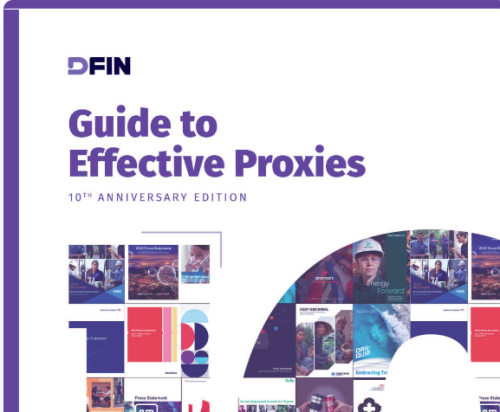What will next year’s annual meeting season bring? Janet Dignan canvases opinion from some of the individuals most likely to know
Forecasting the future can be a fool’s game for all manner of people, whether they’re meteorologists, investors, politicians, journalists, economists or IROs. Nevertheless, trying to anticipate investor reaction to corporate moves is essential for effective engagement, so corporate minds are already squaring up to the likely battlegrounds for the 2015 proxy season.
And that’s a good thing. It suggests the trend toward diplomacy rather than war is continuing, which can only be in the best interests of investors and corporations alike. The growth of genuine shareholder engagement – and not just during the proxy season – has undoubtedly brought improvements for both sides and will hopefully continue to do so.

'We believe a well-managed program of communication can produce substantial benefits'
John Wilcox, Sodali
As Holly Gregory of Sidley Austin puts it, talking about the last proxy round: ‘While concerns about activism and the influence of proxy advisers’ vote recommendations remained high, the 2014 proxy season continued the modest trend toward calmer, less contentious annual meetings.’
The key for companies wanting to avoid those contentious annual meetings of old is to get to know what their shareholders are most concerned about so they can address important and controversial issues before they come to a head. That’s why advisers to companies have been encouraging them to engage with their shareholders out-of-season, with a view to discovering what those shareholders’ current concerns are, demonstrating how past concerns have been addressed and explaining how they might react to continuing concerns in the future.
Nevertheless, a proxy season without some serious differences – even if these don’t always result in full-scale fights – is hard to imagine. The tricky bit is anticipating what those big issues might be. A cursory survey of some of the proxy world’s experts suggests expectations for next year are mostly focused on the board.
John Wilcox, chairman of Sodali and a veteran of many a proxy season, certainly falls into this group. In 2015 he believes ‘shareholders will be pushing for an answer to the most basic governance question: how effective is the board of directors?’
His firm’s client memorandum argues for direct communication between directors and shareholders, ‘but on a limited basis under strict control of management and the board. We believe a well-managed program of board transparency and communication with shareholders can produce substantial benefits for companies, not least of which would be to reduce the threat of being targeted by activists.’
Diversity, refreshment and make-up
Wilcox’s belief that the board will be the focus of the 2015 proxy round is supported by the published results from ISS’ annual global voting policy survey. Its nearly 400 respondents are split between investors and corporates, 70 percent of them US-based with the rest from the UK, continental Europe, Canada and Asia-Pacific. Issues like compensation attract strong views, with a focus both on the overall magnitude of CEO pay and how it’s determined.
For instance, when the survey asks whether there is a threshold at which the magnitude of CEO pay warrants concern regardless of the company’s performance, 60 percent of investor respondents say yes.

'Investors are now increasing their focus on the true drivers of value'
Ron Schneider, RR Donnelley
In terms of board composition, the ISS results indicate that growing numbers of investors ‘are giving weight to the issue of board refreshment and diversity, especially as some markets are establishing quotas or recommended minimum levels for gender diversity on boards.’ Indeed, 60 percent of institutions say they consider overall diversity when evaluating boards.
But what about putting forward their own candidates for a board on a company’s proxy ballot? Back in 2010, when the SEC passed its proxy access rule, US shareholders believed the opportunity to do this was imminent. When the rule was struck down, partly on the grounds that the SEC had not adequately assessed its economic impact, the commission did not appeal the decision and proxy access largely disappeared.
Now, however, CFA Institute has released a report entitled ‘Proxy access in the United States: revisiting the proposed SEC rule’. It examines the costs and benefits of proxy access based on its limited use to date – in markets like Canada, the UK and Australia – and it concludes, inter alia, that proxy access isn’t a good format for special interest groups to gain entry onto boards.
That’s not least because it restricts shareholder nominations to just 25 percent of the board’s seats in any one year and requires ownership of at least 3 percent of the company’s shares for a minimum of three years.
‘Folks who want to have a quicker impact are still going to do their full slates and short slates,’ says Matt Orsagh, director of capital markets policy at CFA Institute. ‘It’s most likely going to be a more long-term pension fund type investor’ that would use it.
The institute hopes the report will help convince the SEC to revisit proxy access. Orsagh says the risk of dissident directors being nominated for up to a quarter of board seats would induce boards to sit down and negotiate with shareowners to iron out any issues. ‘No director or board wants to be embarrassed by not getting 50 percent of the vote,’ he says. ‘So they are all motivated more to talk to shareowners, whatever the issue is.’
He also notes that proxy access was meant to be a device to help hold boards accountable: ‘It won’t be a magic bullet, but we think it’s a tool that will ultimately drive more engagement if it comes about.’
People’s choices
Ron Schneider, director of corporate governance services for RR Donnelley Global Capital Markets in New York, offers his three ‘top picks’ for the big issues of the 2015 season – and they all revolve around board matters, too. His first is director tenure, including issues like director independence, skills and qualifications.
‘With ISS focusing on directors who have more than nine years’ board service, companies and their boards may enhance their disclosure of director skills and qualifications to point out how valuable many of these ‘long-tenured’ directors are,’ Schneider says. He notes that if they fail to do this, they risk being ‘unfairly attacked’ by opportunistic hedge fund activists and others seeking minority board representation.
In the same vein, his second pick is executive compensation performance metrics and their disclosure. ‘With much of the low-hanging fruit of the early say-on-pay years, such as ‘problematic pay practices’, largely having been dispensed with, investors are now increasing their focus on the true drivers of value as opposed to such early distractions,’ he explains.
Proxy season do’s and don’ts
|
And number three? Yes, another issue relating to corporate boards: this time CEO and board succession planning. ‘Investors want to know there is indeed a process and that this is a topic of high-level, regular discussion,’ says Schneider. And he says this is true ‘even if investors don’t see the details.’
Interestingly, the view from Asia isn’t entirely different, according to James Wong of Computershare in Hong Kong. ‘Here in Asia, board diversity and sustainability are not major issues,’ he concedes. ‘They get mentioned mainly because the exchanges are pushing these into corporate governance guidelines.’
Wong says compensation, possible dilution, the pre-emption rights of non-controlling shareholders and connected-party transactions are all drawing more attention from institutional investors than the usual capital deployment and dividend policy issues. But, he adds, ‘director performance and potential or perceived conflicts of interest for independent non-executive directors are also gaining importance.’
CMi2i, the London-based capital markets intelligence company, has just published the results of its Annual Investor Survey Report, which had responses from global institutions managing $6.7 tn. Of those, 55 percent expect their level of engagement with firms to increase in 2015; 45 percent expect it to be the same.
In terms of its anticipated areas of focus, CMi2i reflects the views of other commentators, with a strong emphasis on boards and compensation. Indeed, 100 percent of investors responding to the survey expect to ‘vote against more remuneration policies in 2015’, and 85 percent say they will pay particular attention to compensation when analyzing next year’s proposals. Boards constitute the second-most important concern, especially their composition and effectiveness: 73 percent support separation of the CEO/chairman roles, while 67 percent want annual elections for all directors.
Joele Frank, the New York-based M&A company, has a slightly different take, unsurprisingly. ‘Our predictions for the 2015 proxy season? As busy as ever. In addition to proposals for governance enhancements, say on pay and board diversity, more dollars are being invested in activist-driven funds, including many new activist funds, which will likely lead to even more contested elections.’
The new activist
Ah yes, activists. What are they likely to be up to in 2015? ‘This year, we’ve seen a significant decline in the proportion of activists chasing buybacks or dividends,’ notes Josh Black, editor of Activism Monthly in the UK.
‘We believe this may be a sign of the growing sophistication of activist campaigns, as low-hanging fruit is harvested, but it may also reflect the fact that US companies in particular are returning ever more capital to shareholders independently of specific activist interventions.’ That’s an interesting thought because it’s an indication of the growing willingness to avoid confrontation as corporate governance issues are increasingly addressed through engagement.
Mark Simms, CEO at CMi2i in London, sees a move toward more voting, rather than less – and he believes investment managers are embracing this by increasing their activism. But he quickly adds that ‘this activism is not the same as the traditional adversarial relationship: it’s becoming an investment strategy.
Take, for example, recent noises by European funds around the aborted Pfizer/AstraZeneca deal, AbbVie/Shire and Balfour Beatty/Carillion, where funds have been happy to demonstrate that voting, rather than trading, is the best means of making their point to management.’
Moreover, there is an increasing move by long-only funds – such as the Canadian pension funds, traditionally deemed to be passive – to become more active. This can be done directly, or it can be done indirectly by lending stock to activist funds.
‘Additionally, we have discovered that even sovereign wealth funds – which are restricted from engaging with their investee companies due to the Santiago Principles – are allegedly directing activists to potential courses of action within companies where they hold significant shares,’ says Simms. ‘Obviously, this throws up a need for the issuers to have much deeper knowledge about the behavior and agenda of some of their largest shareholders.’
So this change to the new activism may not make life any easier for issuers, but it will make it different. Companies will need to take a more holistic approach to identifying, understanding and communicating with their shareholders.
And, in Simms’ opinion, ‘there is evidence to suggest that traditional – or adversarial – activism may find resistance, not only from management but also from longer-term shareholders that prefer a more consultative approach to making their views known.’
SDX and red flagsIn February 2014 a working group of some of the biggest long-term institutional investors – BlackRock, Hermes, Ontario Teachers’ Pension Plan, State Street and Vanguard – came together with leading independent directors from companies that included Home Depot and Hertz, as well as law firms and other corporate advisers like Cadwalader Wickersham & Taft and Teneo Holdings to form the Shareholder-Director Exchange (SDX).The group’s idea is to use its collective experience to develop a set of guidelines for shareholder-director engagements, addressing questions such as when such engagement is appropriate and how to make it productive. Above all, its purpose is to open up lines of communication between companies and investors with a view to resolving issues without recourse to expensive proxy battles. The SDX emphasis is on shareholder engagement with companies’ boards, rather than their IROs or corporate secretaries, but the group accepts that in fact a company’s ‘primary investor relations function is vested in its management – specifically in the company’s senior officers and IR professionals.’ It goes on to stress the importance of management and boards being unified and consistent in their shareholder communications and recommends: ‘Except in rare cases where confidentiality from management has been requested, the board should review with management the matters discussed during the engagement.’ SDX offers, among many other things, a list of 20 red flags (see below) ‘that can draw the attention of activists and corporate governance experts and have led to engagement requests or activist campaigns’. But it cautions: ‘The presence of a red flag may not be sufficient reason to engage. Deciding when to make or accept an engagement request is a case-by-case determination based on the company’s or investor’s general philosophy of shareholder-director engagement and other important contextual factors.’ The red flags
|










